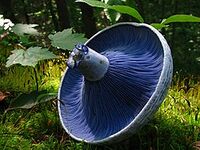Lactarius indigo

Lactarius indigo, more commonly known as the indigo milkcap or blue milk mushroom, is unique for its bold blue coloring. Lactarius indigo is a member of the Lactarius genus, meaning “milk mushroom”; when cut open or bruised, it produces a milky latex (2).
Taxonomy
| Kingdom | Division | Class | Order | Family | Genus | Species | |
|---|---|---|---|---|---|---|---|
| Classification | Fungi | Basidomycota | Agaricomycetes | Russulales | Russulaceae | Lactarius | L.indigo |
Description
Lactarius indigo has a medium-sized cap, about two to six inches in diameter (1). The original shape is dome-like but slightly flattens out with age. It has blue coloring, sometimes with dark blue rings, green bruises, or brown spots if it is older. If dried, Lactarius indigo can turn from blue to a more silvery color. The tops can feel sticky or slimy when fresh and young. The interior flesh is white but turns blue when exposed to the air, and eventually greenish; its taste ranges from mild to acrid. The gills are blue and attached to the stem, or slightly below it. They may be a different shade of blue than the cap, or have a yellow color if it is older. If cut, the gills will release a few drops of blue fluid that later turn green. The spores are cream-colored and broadly ellipsoid with tiny lumps and lines. The stem is short, blue, and typically has shallow pothole-like pits. Like the cap, the gills are sticky or slimy to the touch. Occasionally the stems are hollow (4).
Habitat and Range
Although Lactarius indigo is not common, it is widespread in distribution; it grows in eastern North America, East Asia, Central America, and southern France (1). In the northern hemisphere, Lactarius indigo grows during the wet season between June and September (3). It is capable of fruiting alone or in groups across a wide range of habitats (4).
Ecological Significance
Mycorrhizal associations with oaks and pines allow for beneficial symbiotic relationships (4). This relationship allows for the exchange of minerals and nutrients between the fungus and the host. Lactarius indigo may be of use in future reforestation efforts because of its ability to form ectomycorrhizal interactions (3).
Uses
Lactarius indigo is edible and has a taste similar to portobello but with a much grainier and crumblier texture. It can be eaten fresh, grilled, put into soups, or dried. Its blue color elevates the appearance of any dish it is put in and is the main reason it is sought after (1).
One study supports the idea that Lactarius indigo has antibacterial properties. When tested with different bacteria, Lactarius indigo was found to inhibit the proliferation of some pathogenic bacteria. Although no definite conclusion was reached, it is possible that Lactarius indigo has medicinal properties (3).
Due to the bold blue color of Lactarius indigo, a fluorescent dye can be made and possibly used in the medical field for diagnostic purposes. Azulene, the blue chemical that is found in Lactarius indigo, has been manipulated to create AzuFlour; a new family of molecules. These molecules could be used as a probe in the human body in the future (5).